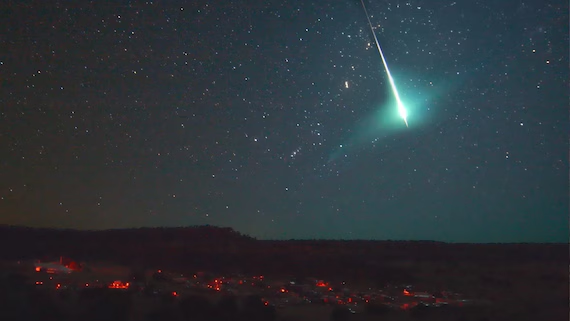Una “scossa di terremoto” in Basilicata in realtà è stata provocata da un meteoroide /An "earthquake" in Basilicata was actually caused by a meteoroid
Una “scossa di terremoto” in Basilicata in realtà è stata provocata da un meteoroide /An "earthquake" in Basilicata was actually caused by a meteoroid
Segnalato dal Dott. Giuseppe Cotellessa / Reported by Dr. Giuseppe Cotellessa
ll 27 dicembre 2023 il passaggio di un meteoroide sopra i cieli della Basilicata ha causato un segnale sismico registrato anche dall'INGV. Ma come è possibile?
Il 27 dicembre 2023 in Basilicata un meteoroide (cioè un piccolo frammento di un corpo celeste più grande che attraversa l'atmosfera terrestre) è entrato in atmosfera facendo registrare un segnale sismico dalla rete INGV. Il Centro di Monitoraggio delle Attività di Sottosuolo (CMS), come confermato in un approfondimento pubblicato il 24 aprile 2024, ha infatti registrato nella zona di Val d'Agri delle onde con velocità “anomale” e non comparabili con quelle di un normale terremoto: nello specifico si sarebbe trattato di una vibrazione partita dall'atmosfera e che solo in un secondo momento avrebbe raggiunto il suolo. Ma andiamo più nel dettaglio.
Come confermato anche dall'INAF (Istituto Nazionale di Astrofisica), la porzione di cielo sopra alla Basilicata la mattina del 27 dicembre 2023 è stata effettivamente attraversata da un meteoroide largo circa 15 cm dal peso approssimativo di 5 kg. Questo oggetto sarebbe entrato in atmosfera a 14,2 km/s (pari cioè a 51.000 km/h) ed avrebbe percorso una traiettoria visibile di circa 228 km.
La conferma di questo fenomeno arriva anche da numerosi avvistamenti del fenomeno, specialmente nell'area di Campoli (MT).
Quando un meteoroide entra in atmosfera genera un segnale perché la sua velocità di ingresso in atmosfera è ipersonica, cioè molto superiore a quella del suono (pari a circa 1200 km/h). Questo comporta che il passaggio del meteoroide nell'atmosfera genera un fronte d'onda di pressione che prende il nome di Cono di Mach: è stato proprio il contatto di quest'onda con la superficie a generare il segnale rilevato dal CMS.
L'aspetto interessante è che se riportiamo su una mappa il tempo di arrivo dei segnali per le varie stazioni, possiamo anche tracciare una rotta approssimativa di questo meteoroide da nord a sud (freccia in bianco) che è però ha direzione opposta rispetto a quanto osservato dall'INAF (freccia in rosso, da Sud a Nord). Da cosa dipende questa apparente contraddizione?
Come spiegato anche dall'INGV, per via del rallentamento dovuto all'attrito con l'atmosfera, la velocità di discesa del meteoroide è circa 6 volte maggiore rispetto alla velocità del suono, e di conseguenza l'onda di pressione legata al cono di Mach trasmessa in verticale raggiunge la superficie terrestre prima a nord (dove la quota di volo del meteoroide è più bassa) che a sud. Quindi all'apparenza potrebbe sembrare che il movimento del bolide sia da nord a sud (freccia bianca) ma, consci di questo "errore" apparente, è possibile confermare la traiettoria corretta da sud a nord.
ENGLISH
On December 27, 2023, the passage of a meteoroid over the skies of Basilicata caused a seismic signal also recorded by INGV. How is it possible?
On 27 December 2023 in Basilicata a meteoroid (i.e. a small fragment of a larger celestial body that passes through the Earth's atmosphere) entered the atmosphere, causing a seismic signal to be recorded by the INGV network. The Subsoil Activities Monitoring Center (CMS), as confirmed in an in-depth study published on 24 April 2024, has in fact recorded waves with "anomalous" speeds in the Val d'Agri area and not comparable with those of a normal earthquake: specifically it would have been a vibration that started from the atmosphere and which only later reached the ground. But let's go into more detail.
As also confirmed by INAF (National Institute of Astrophysics), the portion of the sky above Basilicata on the morning of 27 December 2023 was actually crossed by a meteoroid approximately 15 cm wide with an approximate weight of 5 kg. This object would have entered the atmosphere at 14.2 km/s (i.e. equal to 51,000 km/h) and would have traveled a visible trajectory of approximately 228 km.
Confirmation of this phenomenon also comes from numerous sightings of the phenomenon, especially in the Campoli (MT) area.
When a meteoroid enters the atmosphere it generates a signal because its speed of entry into the atmosphere is hypersonic, that is, much higher than that of sound (equal to approximately 1200 km/h). This means that the passage of the meteoroid in the atmosphere generates a pressure wave front which is called the Mach Cone: it was precisely the contact of this wave with the surface that generated the signal detected by the CMS.
The interesting aspect is that if we report the arrival time of the signals for the various stations on a map, we can also trace an approximate route of this meteoroid from north to south (white arrow) which however has the opposite direction compared to what was observed from INAF (red arrow, from South to North). What does this apparent contradiction depend on?
As also explained by INGV, due to the slowdown due to friction with the atmosphere, the speed of descent of the meteoroid is approximately 6 times greater than the speed of sound, and consequently the pressure wave linked to the Mach cone transmitted vertically, it reaches the Earth's surface earlier in the north (where the meteoroid's flight altitude is lower) than in the south. So on the surface it might seem that the movement of the fireball is from north to south (white arrow) but, aware of this apparent "error", it is possible to confirm the correct trajectory from south to north.
Da:
https://www.geopop.it/una-scossa-di-terremoto-in-basilicata-in-realta-e-stata-provocata-da-un-meteoroide/




Commenti
Posta un commento